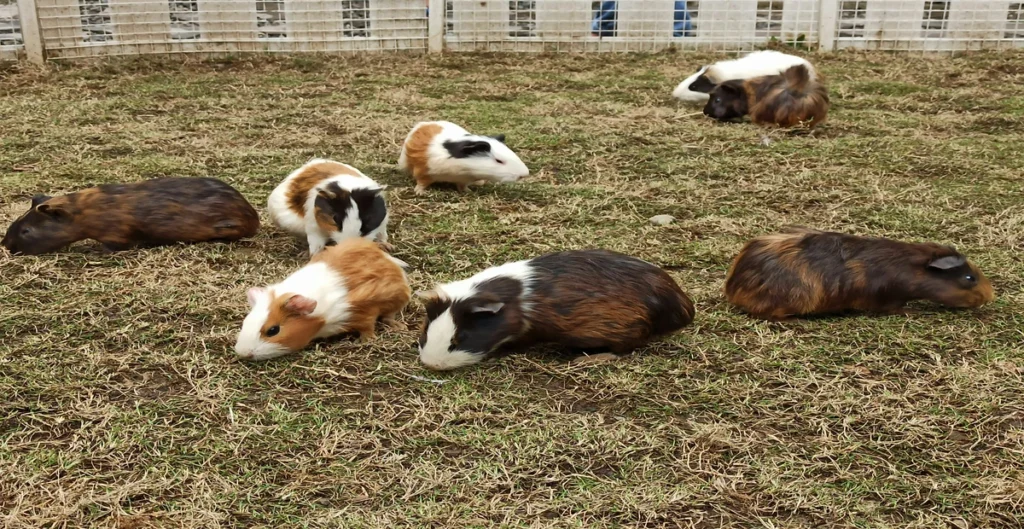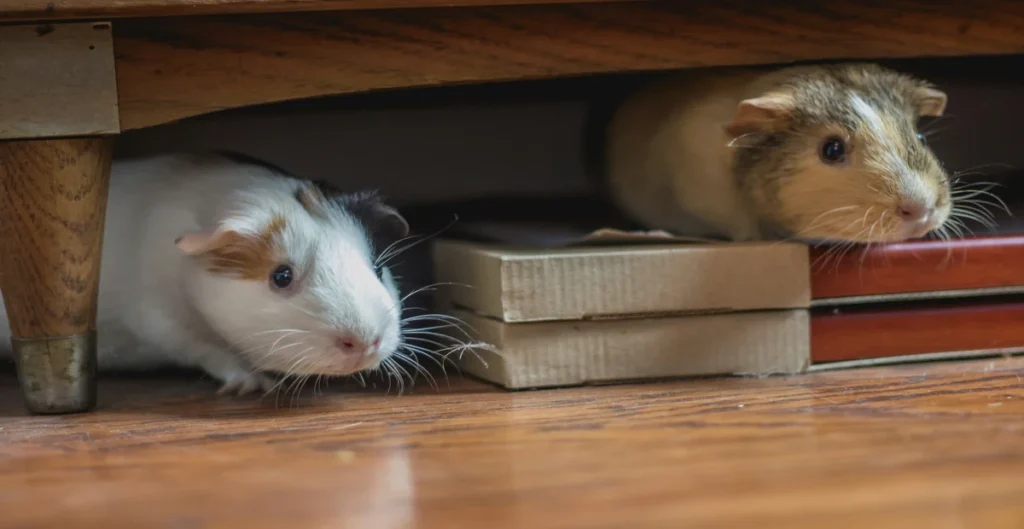Guinea pigs, also known as cavies, are popular pets worldwide due to their friendly nature, manageable size, and diverse range of breeds. With various fur types, colors, and personalities, there is a guinea pig to suit every pet lover’s preference.
This guide aims to answer all your questions about guinea pig breeds, such as “How many breeds of guinea pigs are there?” and “Can different breeds of guinea pigs live together?” By the end of this guide, you will have a deeper understanding of the different breeds, their unique characteristics, and important considerations if you’re considering breeding or adopting these adorable creatures. How Many Breeds of Guinea Pigs Are There?
There are over 13 recognized guinea pig breeds, each with distinct features and care requirements. The number of recognized breeds can vary depending on the country and the specific organization. For instance, the American Cavy Breeders Association (ACBA) and the British Cavy Council recognize slightly different breeds due to regional preferences and breeding practices. Some breeds are more common and widely recognized, while others are rare and lesser-known.

Contents
- Care Requirements
- Personality Traits
- Adoption Tips
- Common Health Issues
- Rare Breeds of Guinea Pigs
- Common Breeds of Guinea Pigs
- Long-Haired Guinea Pig Breeds
- Short-Haired Guinea Pig Breeds
- Breeding Guinea Pigs: What You Need to Know
- Can Different Breeds of Guinea Pigs Live Together?
- FAQs About Guinea Pigs
- What is the friendliest breed of Guinea pig?
- Which type of guinea pig is best?
- What gender guinea pig is best?
- Are 2 guinea pigs better than 1?
- Judgment
- Additional Resources
What Are the Different Breeds of Guinea Pigs?
Guinea pig breeds are generally categorized by their coat type: short-haired, long-haired, and hairless. Each breed has unique characteristics and care needs, making them suitable for different types of pet owners.
List of Guinea Pig Breeds
- American: short-haired, smooth coat, easy to groom, and ideal for beginners.
- Abyssinian: short-haired with a distinctive “rosette” pattern in their fur.
- Peruvian: long-haired with a flowing coat, requires regular grooming.
- Silkie (Sheltie): long-haired, with hair growing backward from the head.
- Teddy: short, dense coat that gives a plush appearance.
- Texel: long, curly coat, similar to a Silkie but with curls.
- Coronet: long-haired, similar to a Silkie but with a “coronet” or crest on the head.
- Rex: a short, rough coat that stands on end, giving a bristly texture.
- Hairless (Skinny Pig and Baldwin): Virtually hairless, with some whiskers and a very thin layer of hair, requiring special care to maintain skin health.
These breeds represent the diversity within the Guinea pig world, with some being more suitable for novice owners and others requiring more experienced care.
Popular Breeds of Guinea Pigs
Some guinea pig breeds are more popular than others due to their temperament, ease of care, and appearance.
- American: The American guinea pig is the most popular breed, known for its friendly nature and short, smooth coat that is easy to maintain. They come in a wide range of colors and patterns, making them a versatile choice for any pet owner.
- Abyssinian: Known for their playful and curious nature, Abyssinians are easily recognizable by their rosette-patterned fur. They are slightly more energetic than the American breed and thrive on interaction.
- Peruvian: Peruvian guinea pigs have long, flowing hair that makes them stand out. They require regular grooming but are often described as docile and friendly, making them a favorite among those who enjoy pet grooming.
Including pictures of these popular breeds can help potential owners visualize the variety and choose a breed that fits their lifestyle.
Care Requirements
Each breed has unique care needs:
- Grooming: Long-haired breeds like the Peruvian need daily grooming, while short-haired breeds require less frequent brushing.
- Diet: A balanced diet with hay, fresh vegetables, and guinea pig pellets is crucial. Some breeds may prefer specific vegetables.
Personality Traits
- American: Friendly and adaptable, making them great for families.
- Peruvian: Often calm and affectionate, thriving with attention.
- Abyssinian: Energetic and curious, they enjoy exploring their environment.
Adoption Tips
When adopting a guinea pig:
- Research: Understand the specific needs of the breed.
- Choose Reputable Sources: Consider adopting from shelters or reputable breeders.
- Health Check: Look for signs of good health, such as clear eyes and a clear coat.
Common Health Issues
Different breeds may face specific health concerns:
- Dental Issues: Common in all breeds due to their continuously growing teeth.
- Skin Problems: Long-haired breeds may experience more skin issues if not groomed properly.
- Respiratory Issues: Guinea pigs are sensitive to environmental changes and should be housed in a draft-free area.
Rare Breeds of Guinea Pigs
Some guinea pig breeds are rare, either due to specialized breeding or less demand among pet owners.
- Baldwin: A unique hairless breed, the Baldwin guinea pig is entirely hairless as an adult, with only a few whiskers remaining. They require specific care to keep their skin healthy, as they are prone to sunburn and need warmer environments.
- Texel: With a long, curly coat, the Texel is less common due to the high maintenance required to keep their curls free of tangles and matting. They are often chosen by enthusiasts who appreciate the unique appearance and are willing to commit to regular grooming.
Rare breeds can offer unique characteristics but may also come with challenges, such as specialized care and difficulty finding breeders.
Common Breeds of Guinea Pigs
Common breeds are those that are frequently found in pet stores and are popular among casual pet owners.
- American: The most commonly found breed in pet stores due to their easy care and friendly disposition.
- Teddy: Also quite common, the Teddy has a distinct short, dense coat that does not require extensive grooming, making it a good choice for families with children.
Common breeds are generally easier to care for, more readily available, and have well-documented health and behavioral traits, making them ideal for first-time guinea pig owners.
Long-Haired Guinea Pig Breeds
Long-haired breeds are known for their stunning coats but require more grooming to prevent mats and tangles.
- Peruvian: Has a straight, long coat that requires daily grooming to prevent matting.
- Silkie (Sheltie): Similar to the Peruvian but with hair that grows backward, Silkie guinea pigs also need regular grooming and are known for their calm temperament.
- Textile requires the most grooming due to its curly, long coat. Owners need to be vigilant with brushing and trimming to maintain coat health.
Long-haired breeds are often chosen by those who enjoy the grooming process and are committed to the care required to maintain these breeds’ beautiful coats.
Short-Haired Guinea Pig Breeds
Short-hair breeds are generally easier to care for and require less grooming, making them suitable for beginners.
- American: The most common short-haired breed, easy to care for, and comes in various colors and patterns.
- Abyssinian: Has a unique appearance with fur that forms rosettes. While they are short-haired, the rosettes can require occasional grooming.
- Teddy: Their dense, plush coat requires less maintenance than long-haired breeds, but regular brushing helps reduce shedding.
Short-haired breeds are ideal for those looking for a low-maintenance pet that still offers a range of colors and personalities.

Breeding Guinea Pigs: What You Need to Know
Breeding Age for Guinea Pigs
Guinea pigs reach sexual maturity at a young age, around 2-3 months for females and 3-4 months for males. However, it is recommended to wait until a female is at least 4-6 months old and a male is around 5-6 months old before breeding to ensure they are physically mature enough to handle the demands of reproduction.
Is breeding Guinea Pigs profitable?
Breeding guinea pigs can be rewarding, but it is not typically profitable. The costs associated with breeding, such as proper housing, nutrition, veterinary care, and time commitment, often outweigh any potential profits. Responsible breeders prioritize the health and well-being of their animals over profit.
Breeding should only be undertaken by those with a thorough understanding of guinea pig genetics, health, and care requirements, and not as a means of generating income.
Can Different Breeds of Guinea Pigs Live Together?
Different breeds of guinea pigs can generally live together harmoniously as long as their personalities are compatible. It is important to introduce guinea pigs to each other slowly and carefully to ensure they do not fight or become stressed. Here are some tips for housing different breeds together:
- Consider temperament: Some breeds, like the American and Abyssinian, tend to be more outgoing and social, while others, like the Peruvian, may be more reserved. Matching similar temperaments can lead to a more harmonious living situation.
- Monitor Health and Grooming Needs: Long-haired breeds will need more grooming, so if housed with short-haired breeds, owners must ensure all Guinea Pigs receive appropriate care.
- Provide Adequate Space: Ensure the cage or enclosure is spacious enough to allow for personal space, as overcrowding can lead to stress and aggression.
With the right approach, different breeds can coexist peacefully, enriching each other’s lives and providing companionship.
FAQs About Guinea Pigs
What is the friendliest breed of Guinea pig?
The American guinea pig is known for its friendly and social nature, making it a popular choice for families and beginners.
Which type of guinea pig is best?
The best type of guinea pig depends on your preference. However, the American and Peruvian breeds are often recommended for their friendly demeanor and easy care.
What gender guinea pig is best?
Both male and female guinea pigs can make great pets. However, females are generally more social, while males can be more laid-back.
Are 2 guinea pigs better than 1?
Yes, guinea pigs are social animals and thrive in pairs or small groups. Having two can prevent loneliness and encourage playful behavior.
Judgment
Guinea pigs are delightful pets with a wide variety of breeds to choose from. Whether you are drawn to the easy-care nature of short-haired breeds or the unique beauty of long-haired breeds, there is a guinea pig out there for every pet lover. Understanding the different breeds, their needs, and how they can live together is crucial for providing the best care possible. If you’re considering breeding, it’s important to approach it with responsibility and knowledge. Guinea pigs can bring joy to your home, and with the right care and understanding, they can thrive in any environment.
Additional Resources
- Guinea Pig Care Guide: Learn more about feeding, housing, and general care.
- Choosing the Right Guinea Pig for You: Tips on Selecting a Breed That Matches Your Lifestyle.
- Adoption Centers and Breeders: Recommendations for reputable sources to find your next Guinea Pig.
By understanding the various breeds and their unique needs, you can make informed decisions that will ensure a happy and healthy life for your Guinea pig companions.



